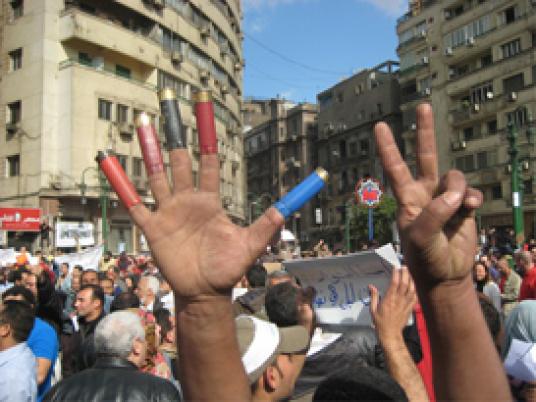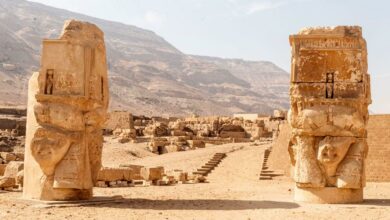
A couple of hours before the screening of the documentary “Tahrir 2011: The Good, the Bad, and the Politician” at the 4th Panorama of the European Film on Friday 25 November, one participant in the demonstrations in Tahrir Square, Ayman Farag, tweeted: “The film Tahrir 2011 is showing at Galaxy Cinema today. Who the hell would go to that?”
It does seem absurd. Who would go watch a movie about Tahrir in 2011 when the year is 2011, you live in Cairo and Tahrir Square is, at the time of the film’s screening, as full of protestors as it was in February? But to answer the question, lots of people would go, and did.
“Tahrir 2011” is among the first of several feature-length films about Egypt’s revolution that, having garnered praise at international festivals, have been screened in Egypt, though it is, in reality, more of a vehicle for the distribution of three short films than a unified work. The film does not propagate the simplistic narrative embraced so enthusiastically by a wide range of recent productions. The second segment, “The Bad,” directed by Ayten Amin, is a fascinating look into the perspective of the police and Central Security officers who brutally fought back protestors in January. In “The Politician,” a comical examination of Hosni Mubarak’s various dictatorial tendencies, director Amr Salama takes obvious pleasure in poking fun at the deposed autocrat. But the first chapter, “The Good,” directed by Tamer Ezzat, is essentially indistinguishable from countless other films that recount the story of the 18 days with familiar narrative signposts and cues for applause.
The urge to dwell on those early, victorious days that kicked off what will continue to be an unpredictable period of transition and – hopefully – transformation has been irresistible to filmmakers since the early days following Mubarak’s resignation. That narrative continues to enchant audiences, told again and again like a favorite bedtime story. But whether it be the slew of documentaries about the revolution screened as a part of the Alexandria Film Festival in October, or the nationalist ballet “The Pyramids and the Revolution," the widening gap between the insatiable need to retell the story of the 18 days and the visible reality of an ongoing struggle for change has, with the recent reoccupying of Tahrir Square, become unbridgeable.
Capturing a time of upheaval is not a simple task, and it is almost certainly too early to do so in any meaningful, lasting way. While it may seem ridiculous to watch any film about a revolution that you may well be living through yourself, certain offerings in the Panorama’s “Revolutions” program served to demonstrate that revolutionary moments, defined by such vibrant and violent states of flux, cannot accurately be depicted in a static narrative, now or ever. “Le fond de l’air est rouge,” in English titled “Grin Without a Cat,” a three-hour epic film-essay by French New Wave director Chris Marker, defies traditional narrative structure, tackling radical movements from the ‘60s and ‘70s in France, Cuba, Chile, the United States and elsewhere from all angles. Within the hours of footage culled and the scores of opinions sought, Marker, himself devoted to the ideas he is depicting, searches for some kind of understanding of what the leftist ideologies briefly at the forefront of politics around the world could have accomplished, what they did accomplish and why they did not accomplish more. The documentary, through fluid juxtaposition, questions the viability of ideology in the face of practical realities, the ways good ideas can be twisted for dark purposes and many other conflicting currents of those tumultuous years.
Taking a more personal and naïve perspective on the same time period is “Mourir a 30 ans” (Half a Life), the first feature film by Romain Goupil, a French director whose long career has been marked by unflinching devotion to leftist politics. Produced in 1981, only a few years after the suicide of his comrade in revolution, Michel Recanati, “Half a Life” documents the same movements of the late ‘60s through the extensive footage Goupil recorded from his earliest days as a juvenile troublemaker to his and Recanati’s extensive work as activists and agitators.
Through Goupil’s youthful eyes, the film shows the seduction of the very idea of revolution – and the way that an idea can gradually separate itself from the purpose and goals of a movement. Near the end of the film, Goupil speaks of the difficulty of making political films and the ideological tunnel vision that dug a chasm between his militant ideals and the broader public, saying, “We were no longer moviemakers, but self-congratulatory illustrators.”
The line can sometimes be a fine one. It is a trap that more than a few filmmakers have fallen into in recent months.
Though of higher quality than most, “Tahrir 2011,” along with such documentaries as “The Agenda and I," will likely serve as a testament to one specific historical moment, emerging from the elation following Mubarak’s resignation but not speaking to the nature of the larger struggle in Egypt.
But maybe in a few years, a filmmaker or two will approach this period with some distance and be able to depict the situation in its myriad complexities, to examine the revolutionary moment as a moviemaker and not an illustrator. The events of the past weeks have made it clear, at least, that the time for pat narratives telling the straightforward story of a problem solved has now passed.




